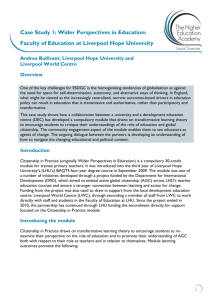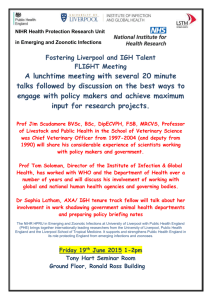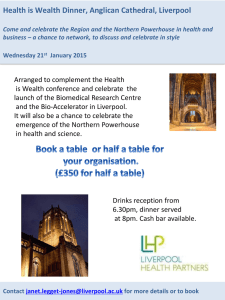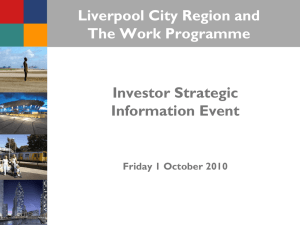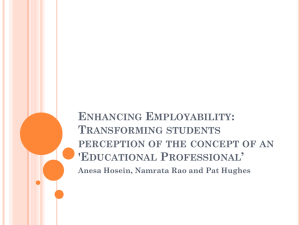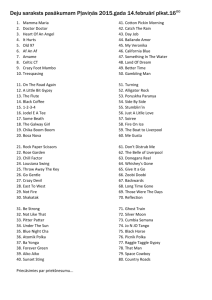Case Study 25 The Importance of a socially conducive institutional
advertisement
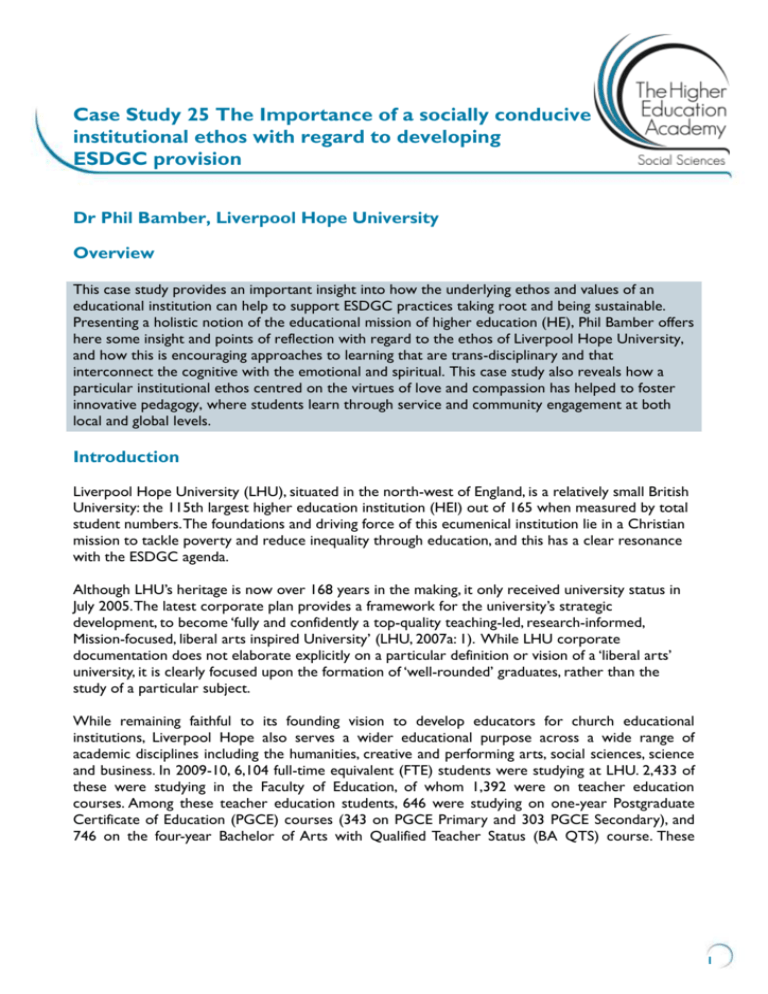
Case Study 25 The Importance of a socially conducive institutional ethos with regard to developing ESDGC provision Dr Phil Bamber, Liverpool Hope University Overview This case study provides an important insight into how the underlying ethos and values of an educational institution can help to support ESDGC practices taking root and being sustainable. Presenting a holistic notion of the educational mission of higher education (HE), Phil Bamber offers here some insight and points of reflection with regard to the ethos of Liverpool Hope University, and how this is encouraging approaches to learning that are trans-disciplinary and that interconnect the cognitive with the emotional and spiritual. This case study also reveals how a particular institutional ethos centred on the virtues of love and compassion has helped to foster innovative pedagogy, where students learn through service and community engagement at both local and global levels. Introduction Liverpool Hope University (LHU), situated in the north-west of England, is a relatively small British University: the 115th largest higher education institution (HEI) out of 165 when measured by total student numbers. The foundations and driving force of this ecumenical institution lie in a Christian mission to tackle poverty and reduce inequality through education, and this has a clear resonance with the ESDGC agenda. Although LHU’s heritage is now over 168 years in the making, it only received university status in July 2005. The latest corporate plan provides a framework for the university’s strategic development, to become ‘fully and confidently a top-quality teaching-led, research-informed, Mission-focused, liberal arts inspired University’ (LHU, 2007a: 1). While LHU corporate documentation does not elaborate explicitly on a particular definition or vision of a ‘liberal arts’ university, it is clearly focused upon the formation of ‘well-rounded’ graduates, rather than the study of a particular subject. While remaining faithful to its founding vision to develop educators for church educational institutions, Liverpool Hope also serves a wider educational purpose across a wide range of academic disciplines including the humanities, creative and performing arts, social sciences, science and business. In 2009-10, 6,104 full-time equivalent (FTE) students were studying at LHU. 2,433 of these were studying in the Faculty of Education, of whom 1,392 were on teacher education courses. Among these teacher education students, 646 were studying on one-year Postgraduate Certificate of Education (PGCE) courses (343 on PGCE Primary and 303 PGCE Secondary), and 746 on the four-year Bachelor of Arts with Qualified Teacher Status (BA QTS) course. These 1 figures reveal that nearly a quarter of FTEs at LHU were studying teacher education, explaining the vice-chancellor’s claim at graduation in 2011 that Education is the ‘Foundation’ faculty of the institution; this proportion has remained fairly constant since 2004-05. A holistic vision of HE The philosophy of education to which LHU subscribes has a holistic orientation as reflected in the university’s mission, which has stated that it strives to ‘provide well-rounded personal development… educating the whole person in mind, body and spirit’ (LHU, 2012a) since Liverpool Hope University College was established in 1995 (Pye, 2009: 30). Furthermore the values to which LHU aspires, and which it states are integral to the fulfilment of this mission, include that it ‘strives to be well-rounded, holistic, integrated, a team, a community of communities, collaborating in wider partnerships’ (LHU 2012b). This emphasises the importance of relationships, collegiality and working collaboratively. Indeed it is claimed that the mission and values of the institution ‘encourage the development of a University with a collegial heart’ (LHU 2007a: 1). The mission and values statements to which LHU aspires are both preceded by the phrase ‘strives to’. This implicitly recognises that the university as a whole is involved in a process of becoming: as a community of communities and as individual staff and students. The challenges facing society have been described as being ‘bigger-than-self’ (WWF, 2010), and clearly such fundamental problems require bigger-thanself solutions. A socially conducive institutional ethos, as demonstrated by this case study, provides an important foundation for ESDGC. A recent audit by the Quality Assurance Agency (QAA, 2009) identified ‘the ethos, culture and mission of the University’ as being a feature of best practice, concluding that the mission ‘is understood, acknowledged and appreciated by both staff and students and… clearly underpins the work of the institution’ (p 4). This suggests that the mission and ethos of the institution are not simply ‘intended’ but also ‘experienced’ (McLaughlin, 2005: 313). This is validated by the 2011 inspection of initial teacher education (ITE) at the institution that concluded: ‘Trainees demonstrate a strong moral purpose. They are very good practitioners technically and demonstrate the strong sense of vocation embodied in the provider’s vision for the Hope Graduate’ (Ofsted, 2011: 4). Furthermore, this report suggested LHU’s mission and values underpinned partnership with local schools and non-governmental organisations, recognising the ‘excellent relationships across the strong partnership, where all have high levels of commitment to the Hope vision’ (Ofsted, 2011: 4). The theological virtues of faith, hope and love, in addition to the cardinal virtues of prudence, temperance, justice and fortitude, provide an important ethical framework for LHU as an institution with a Christian foundation seeking to serve wider society (LHU, 2011a). For example, ‘Faith, hope and love’ appear on the university crest. These virtues have not only personal but also social and civic dimensions: they are both self-regarding and other-regarding. Certainly, ‘love’ in the senses of agape (described by some as an active concern for wellbeing), storge (familial love), and philia (brotherly love) between students and others locally and globally, might provide an alternative framework for thinking about ESDGC. This does not only involve the development of informed, skilled behaviours and ways of thinking, useful in the short-term as encapsulated in Vare and Scott’s (2007) ‘ESD1’, but demands exploration of the dilemmas and contradictions inherent in sustainable living (as typified by their ‘ESD2’). 2 Global co-operation with global competitiveness The marketisation of higher education has renewed focus on graduate employability. Rather than being a ‘view from nowhere’, this represents a particular philosophy of education. LHU has sought to balance the promotion of skills that are sought by employers alongside attributes that are important to life in a humane, educated democracy. An aspiration to be ‘market-informed, rather than market-driven’ (LHU, 2007a: 4) is also reflected in the university’s website section on ‘What makes LHU different’: We do not believe that education is just about equipping people for the world of work; we also educate students for the work of the world. We believe that only students educated within a global context can constructively, fairly and bravely make the changes the world needs. (LHU, 2011a) The ‘work of the world’ reveals an aspiration to catalyse personal growth that makes social change possible. This is reflected in the visioning statement of the Faculty of Education which states ‘the guiding orientation of the Faculty is to develop educational thought and practices which promote education as a humanising influence on each person and on society locally, nationally and internationally’ (McGettrick, 2010: 2). In other corporate documentation, however, a desire to secure graduate employability morphs into an aspiration to create global citizens that live out the mission of the institution: The experience [of studying at LHU] will equip a Hope graduate to be an informed, confident global citizen with the appropriate skills and attributes sought by employers. (LHU, 2007a: 6) Faculties should consider how they can more effectively serve the needs of students and their future employability by creating better opportunities for student volunteering and experiential learning within the formal academic structures. It is arguable that all students should acquire basic skills in global citizenship. (LHU, 2007b: 7) These excerpts from publicity illustrate the overlapping practices of education for global cooperation and global competitiveness. Service learning: from local to global Over the last 20 years, nearly 500 LHU staff and students have volunteered to support educational development projects in resource-poor communities overseas, and LHU has recently launched an extra-curricular ‘Service and Leadership Award’ (SALA) to recognise student service in local and global contexts. There are various elements to this programme, which provides students with the opportunity to complete service and leadership activities both locally and internationally. Students complete a reflective portfolio alongside their service activity, whether local or global, to self-assess against competencies relating to leadership, teamwork and communication. These relate both implicitly and explicitly to the mission and values of the university. For example, leadership competencies include ‘Exercising servant leadership – as part of teamwork – in service contexts’ 3 and ‘Demonstrating a commitment to the principles and practice of social justice as these relate to the mission’ (LHU, 2011b). Academic and support staff volunteer as SALA mentors to support students through this process. LHU’s most recent learning, teaching and assessment strategy was designed ‘to promote active student engagement, ‘deep’ learning and successful completion by well-educated and rounded graduates’ (Norton 2009: 3). It presents a strategy that aims to put ‘relationships at the heart of learning and teaching’ (Norton 2009: 9-11), with an ambition that service is embedded within the curriculum, claiming students in all subjects can become confident learners through provision of ‘opportunities for a rounded education that shapes life and vision, such as intercultural learning, experience of other cultures and contexts, engagement in service and voluntary work’ (Norton, 2009: 5). To conclude, I will provide one further example to demonstrate how working within such an institution can help advocates of ESDGC to promote this agenda. Until recently, undergraduate ITE students at LHU completed a seven-week placement in schools as part of their penultimate year. Instead, students now complete a five-week school placement and ten days of community engagement. This change was brought about to help our students develop their understanding of ESDGC with respect to their role as teachers, and promote a sense of themselves as active global citizens. It aims to consolidate and deepen their understanding of and disposition towards ESDGC. It also enables them to gain a broader experience of education beyond traditional teaching practice or school-based learning. The students are introduced to ESDGC policy and practice in the UK and encouraged to incorporate ESD methodologies within their teaching practice and community engagement placement. In doing so, this intervention aims to transform student perspectives on the role of education and their own philosophy of teaching. Indeed, we have found that it is through this experience that students begin to think critically about curriculum and pedagogy, exemplifying pivotal aspects of ‘ESD2’ (Vare and Scott, 2007). This example further validates the claim that the ethos detailed above is both ‘intended’ and ‘experienced’ (McLaughlin 2005: 313). Furthermore, it could be argued that a socially conducive institutional ethos is an important catalyst for the ‘social learning process of improving the human condition’ (Vare and Scott, 2007: 194). References Liverpool Hope University. (2007a) Corporate Plan 2007-2011. Unpublished. Liverpool Hope University. (2007b) Hope One World Review: Final Report and Recommendations. Unpublished. Liverpool Hope University. (2011a) About Liverpool Hope University [online]. Available from: http://www.hope.ac.uk/aboutus/theliverpoolhopestory/ [8 July 2013]. Liverpool Hope University. (2011b) Service and Leadership Award Competencies. Unpublished. Liverpool Hope University. (2012a) Liverpool Hope University Mission Statement [online]. Available from: http://www.hope.ac.uk/aboutus/theliverpoolhopestory/missionandvalues/ [8 July 2013]. 4 Liverpool Hope University. (2012b) Liverpool Hope University Values [online]. Available from: http://www.hope.ac.uk/aboutus/theliverpoolhopestory/missionandvalues/ [8 July 2013]. McGettrick, B. (2010) Faculty of Education, Liverpool Hope University, 2010-12 Strategic Map. Unpublished. McLaughlin, T. (2005) The educative importance of ethos. British Journal of Educational Studies. 53 (3), 306-325. Norton, L. (2009) The Learning, Teaching and Assessment Strategy for taught undergraduate degree 2009-2012 [online]. Available from: http://www.hope.ac.uk/media/liverpoolhope/contentassets/documents/policiesandprocedures/medi a,1036,en.pdf [8 July 2013]. Ofsted (2011) Liverpool Hope University: Initial Teacher Education Report June 2011 [online]. Available from: http://www.ofsted.gov.uk/inspection-reports/find-inspection-report/provider/ELS/70130 [5 April 2012]. Pye, K. (2009) A Brighter Hope: The Story of Liverpool Hope University. Liverpool: Liverpool Hope University Press. Quality Assurance Agency (QAA). (2009) Institutional Audit: Liverpool Hope University [online]. Available from: http://www.qaa.ac.uk/InstitutionReports/Reports/Documents/RG548LiverpoolHope.pdf [4 April 2012]. Vare, P. and Scott, W. (2007) Learning for a Change: Exploring the relationship between Education and Sustainable Development. Journal of Education for Sustainable Development. 1(2), 191-198. World Wide Fund for Nature (WWF). (2010) Common Cause: The Case for Working with our Cultural Values. Available from: http://assets.wwf.org.uk/downloads/common_cause_report.pdf [6 April 2012]. 5
